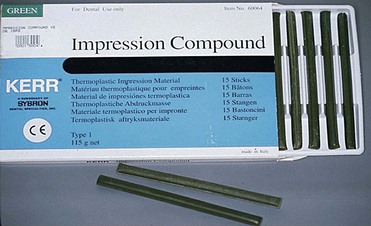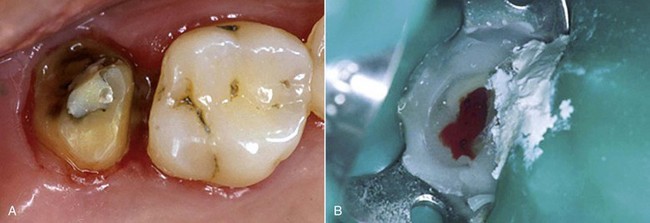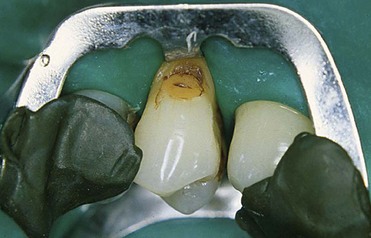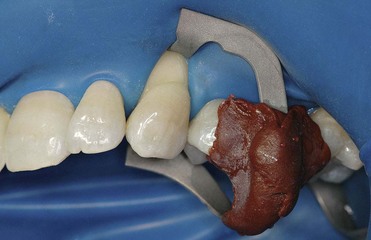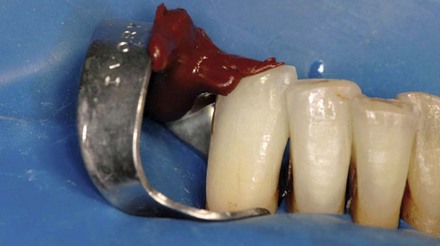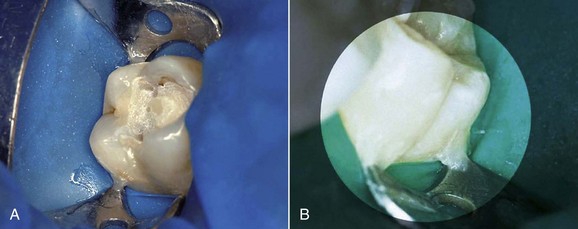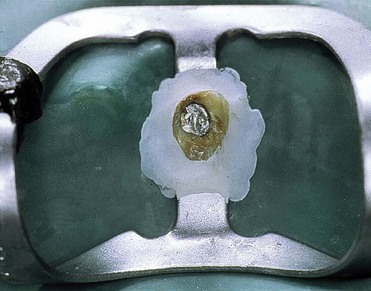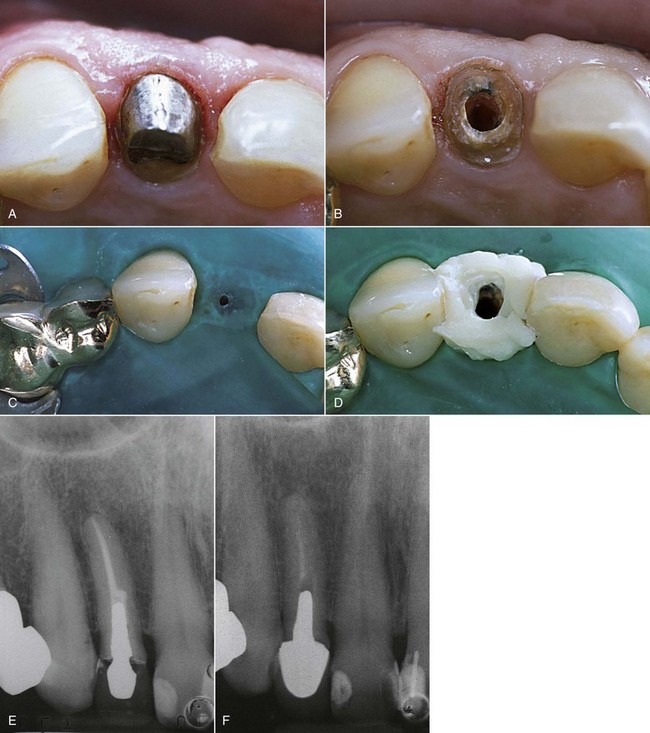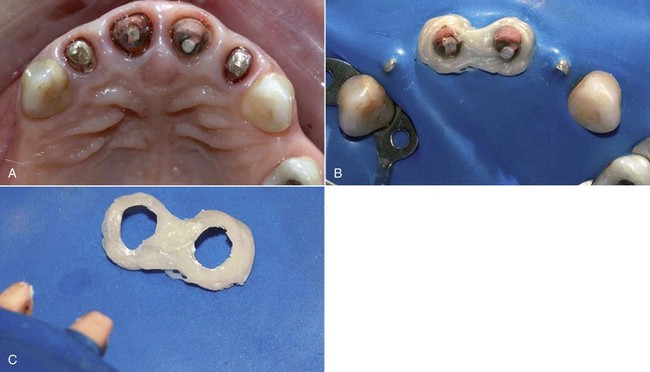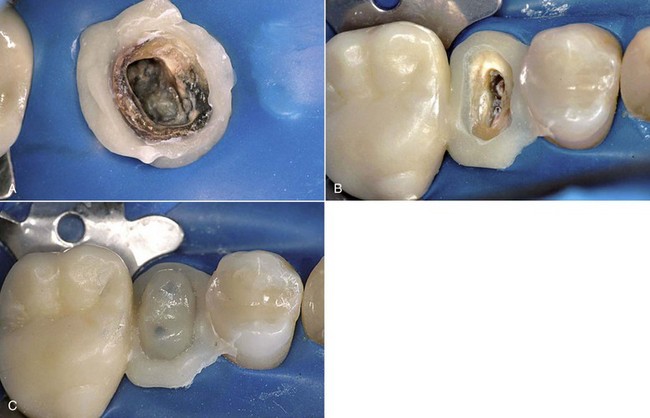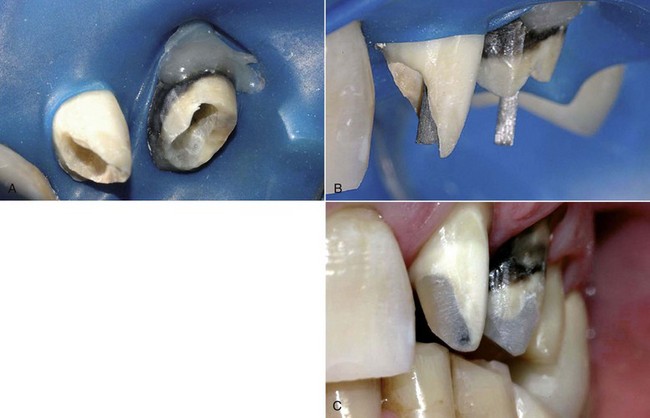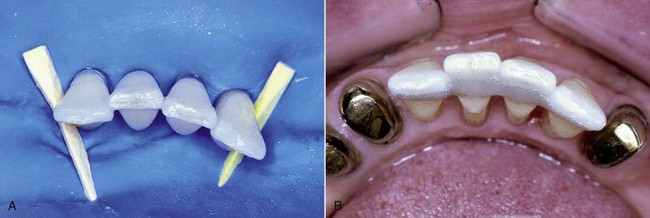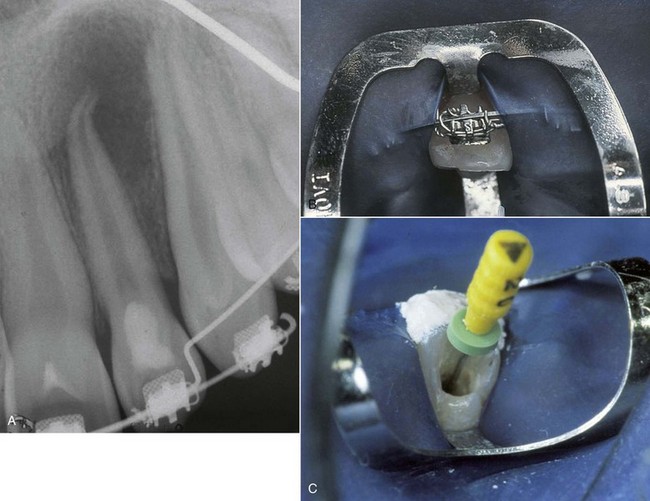Isolation of the Operative Site
Stabilization of the Clamps
Thermoplastic Impression Compound
The chief material used for clamp stabilization is thermoplastic impression compound (Figure 3-1), which is commercially available in three colors: green, red, and black.
Dr. Robello, an expert in isolation of the operative site, recommends the black compound because it makes the clamps more stable after cooling. Before use the thermoplastic compound is softened over a flame; it is then applied to the bow of the rubber dam clamp to be stabilized (Figure 3-2).
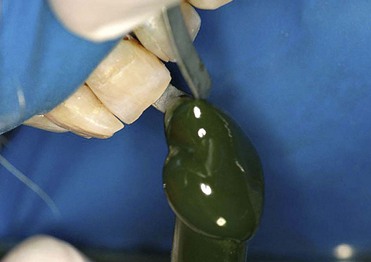
Figure 3-2 Classic case of blocking a #212 clamp.
Vaseline, soap, or plain water is applied, and the thermoplastic compound is adapted around the bow(s) of the clamp and the adjacent teeth (Figure 3-3).
When the jaws of the clamp are not very stable because of the shape of the tooth, plenty of thermoplastic compound should be used, and it should be compressed into the natural retentions of the adjacent teeth and placed on both bows to keep the clamp from snapping off (Figure 3-4).
Some modified clamps lose retention on the tooth and thus require a larger amount of thermoplastic compound (Figure 3-5).
When the adjacent anchoring teeth are missing, it may be advantageous to use two modified clamps that have been joined together and stabilized by a rigid object (e.g., a bur) and the thermoplastic compound material (Figure 3-6).
Stabilization is essential not only for monoradicular teeth. In special cases, when the jaws of the clamp do not engage the exposed root surface properly, the thermoplastic compound can be placed between the bow and the occlusal surface of the tooth, thus preventing rotation of the clamp (Figure 3-7).
Working on the occlusal surface of the tooth embraced by the clamp requires a different technique. The distal jaw of the clamp is etched with a punctiform pattern, followed by placement and polymerization of a small amount of composite, which prevents displacement of the clamp (Figure 3-8). When the adjacent teeth needed for stable blockage of the bows are missing, or during removal of a preexisting prosthesis that leaves a very small abutment, a dual-cured glass-ionomer cement (GIC) can be used to create a single block between the jaws and the abutment, ensuring good stability for subsequent treatment (Figure 3-9).
In the event of second upper molars affected by pulpitis (Figure 3-10), stable clamp positioning can be achieved in two ways: by modifying the tooth shape to provide better grip for the clamp, or by using a clamp for premolars blocked with a mass of GIC.
Use of the Thermoplastic Compound
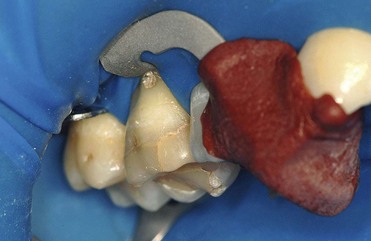
Figure 3-3 The thermoplastic compound is placed around the bow of the clamp and on the adjacent teeth.
Sealing the Rubber Dam Sheet
Stabilization is required not only for the clamps but also for the rubber dam sheet. When removal of a post and core and crown leaves a tooth without coronal tissue (Figure 3-11, A and B), the rubber dam is placed as if the tooth were intact (Figure 3-11, C). GIC is then injected around the root, while the hole is simultaneously held open around the root. This maneuver takes just 30 seconds and can be repeated if multiple endodontic sessions are required (Figure 3-11, D and E). When two adjacent abutments must be treated (Figure 3-12, A), the sheet of the rubber dam can be blocked against the abutments (Figure 3-12, B). The material is detached with a crown remover at the end of the treatment (Figure 3-12, C).
The same technique can be used for the posterior sectors, when the clamp is placed distally (Figure 3-13, A to C).
Examples of Sealing the Rubber Dam Sheet
Flowable composite can also be used. When removal of the crowns leaves a tooth that cannot be isolated without additional clamps, the flowable composite is placed without etching at the most cervical point of the teeth to be treated. This procedure permits completion of the preprosthetic restoration in a dry environment without the encumbrance of any clamps (Figure 3-14, A and B). The material is then eliminated once the rubber dam sheet has been removed (Figure 3-14, C).
Another special case occurs when splinting is required but distally there are only telescopic crowns. In this case, placement of the clamp would create accessibility problems. Therefore the rubber dam sheet is blocked with two wedges to keep it in place (Figure 3-15, A and B).
Sometimes stabilization simply involves obtaining a proper waterproof seal for the rubber sheet without physical stabilization. In the event of an emergency root-canal treatment in an orthodontic patient with brackets and an orthodontic arch, it is sufficient to place a specially designed foam in the areas communicating with the oral cavity (Figure 3-16, A to C).
Stay updated, free dental videos. Join our Telegram channel

VIDEdental - Online dental courses


